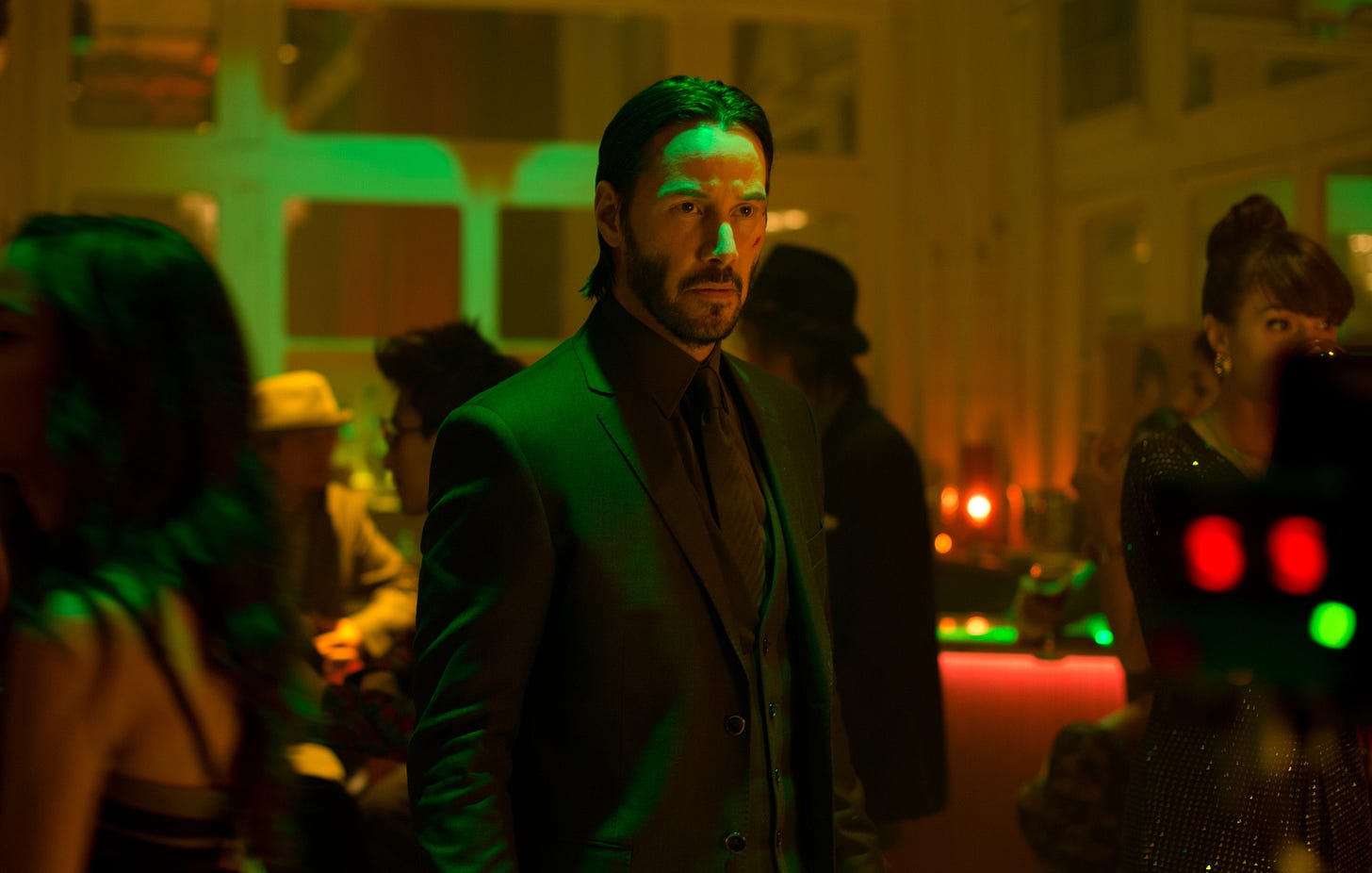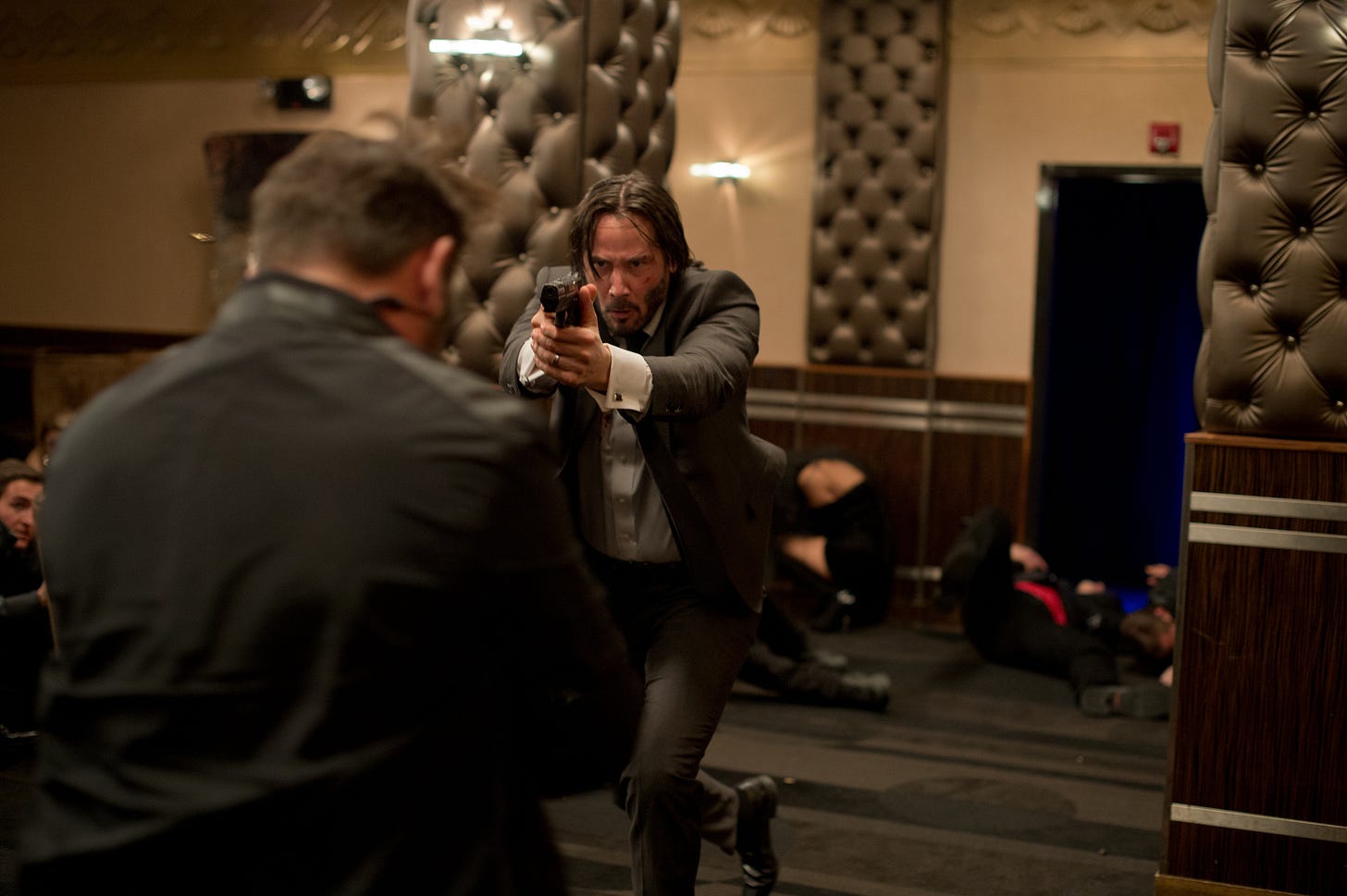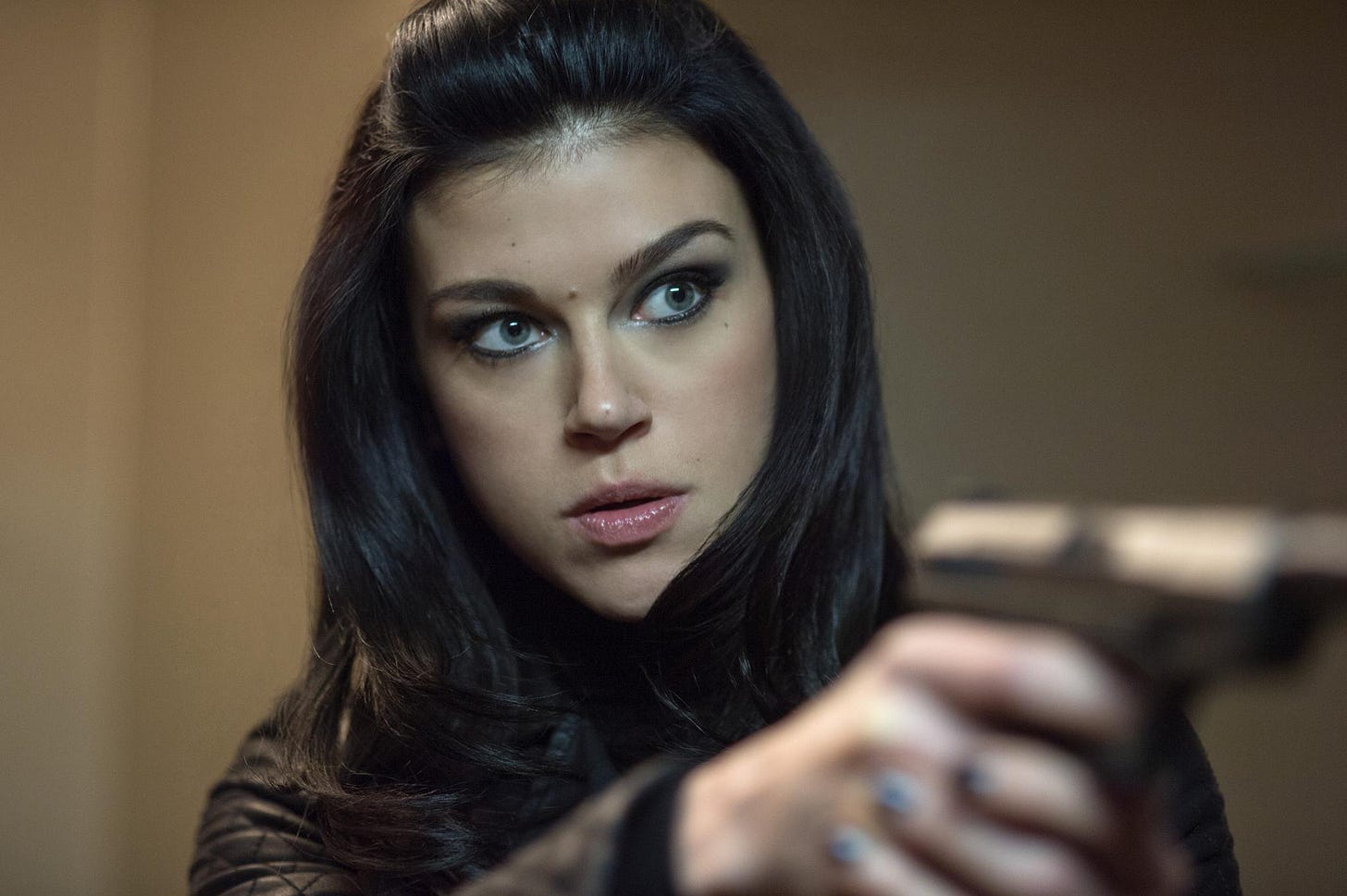John Wick: An Off-Balance Retrospective.
The influential action film turned 10 last week.
While Off-Balance will remain free, without any paid subscriptions, if you want to support my work in a different way?
You could, if you’re so inclined, potentially buy me a beer instead: just click the link below.
Thanks for reading!
Until next time,
Ryan.
When you consider the hurdles it had to overcome, here now, with ten years of hindsight, it is frankly pretty impressive that the first John Wick movie even managed to get off the ground.
On one hand, there was creator and credited screenwriter, Derek Kolstad.
Talented no doubt but even after paying his dues and steadily working his way up the Hollywood ladder, he was far from a sure thing.
On the other, maybe it was the similar uncertainty surrounding star Keanu Reeves, where, following a string of missteps, he was no longer considered a consistent, box-office draw.
There was too, the movie’s co-directors, Chad Stahelski and David Leitch (of which only Stahelski was credited), former stuntmen/stunt coordinators, both in their directorial debuts and trying to make a big jump creatively. Yet even with that baseline potential, until Eva Longoria, in a producing role, put up six million dollars of her own money at the eleventh hour, to keep the production afloat? The entire project was nearly shuttered.
And speaking to The Hollywood Reporter, earlier this month Stahelski acknowledged as well, the difficulties faced even after filming wrapped. Walk-outs during test screenings, indifferent studio heads and a general inability for those who weren’t actively involved in the film to truly embrace the inherent eccentricity present in the material.
Though compared to the experience that comes in actually watching the movie, all that stands in sharp contrast: you’d never know it.
John Wick. From start-to-finish, it simply oozes confidence and style. In every supremely-impressive action set-piece, each, choreographed down to the smallest detail, with its Hong Kong cinema-indebted flair. The around-the-edges world-building or the art design and lighting in every noir-soaked frame.
Each line of pulpy dialogue, from the bit parts to the main cast, delivered with the upmost seriousness.
It would become, of course, just the start of something bigger.
The movie, a darling of critics and audiences both, would more than make back its budget, while Reeves, as the titular hitman, would see both his career and larger cultural profile revitalized. And over the following years, as it influenced its niche genre and Western action films wholesale, John Wick would become the first in a franchise. Having been followed, so far, by three direct sequels, a TV series prequel, and as of this writing, two confirmed spin-off films.
The long-in-development Ballerina, staring Ana De Armas that is currently set for a 2025 release and an untitled Donnie Yen helmed project, which will focus on his character following the events of John Wick: Chapter 4.
Though when lined up next to its increasingly bombastic successors, more-and-more, when returning to it? One really can appreciate the relative simplicity of the first John Wick film.
Never reaching too far or asking the audience for too much but at same time, never overplaying its own hand.
But just how well does it hold up, a decade on, following its initial release in October of 2014?
Well, let us take a look back.
After his wife, Helen (Bridget Moynahan) dies from an unspecified illness, John Wick (Keanu Reeves), heartbroken and inconsolable, retreats inwards.
Soon arriving on his doorstep, however, is Helen’s final act of kindness, a last gift to her husband. A beagle puppy and with it, the hope that he won’t allow himself to be consumed with grief.
But when Russian mobster Iosef (Alfie Allen), out of spite for a previous encounter, callously burglarizes John’s home: beating John, stealing his car and killing the dog, he unknowingly marks himself for an untimely end.
For long ago, John was known simply as Baba Yaga: The Boogeyman.
A hitman so renowned, so feared, any mention of his name alone would command respect. And as he returns to the New York City underworld he tried so hard to leave behind? John will stop at nothing at exact his vengeance, no matter the cost.
All-in-all, from its basic beats to its overall structure, it is pretty standard, revenge fantasy fare - but what immediately sets John Wick apart is in the (often literal) execution.
Stahelski/Leitch and Kolstad, presenting a world that, right from the jump, is, on various fronts, utterly rich with character. Feeling both a touch fantastical (almost comic-book-esque, albeit in the best possible way) but authentically lived-in too.
From the hyper-noir look created by cinematographer Jonathan Sela or Elísabet Ronaldsdóttir’s slick editing, which never allows the action to waver, to the now-iconic world-building.
There is The Continental, the hiding-in-plain-sight hotel in Manhattan, which acts as a safe haven for the network of hitman and hitwomen spread across the city. Though not a den of debauchery it is instead, a place where its rules, “the code”, are strictly enforced.
Put up your feet at the bar, for there is to be no killing, no business, conducted on the grounds.
Though maybe it is the reveal that everything in Wick’s underground circuit is paid for in specialized gold coins. From hotel rooms to calling in the cleaner (“a dinner reservation”). And while it may veer into campiness at times, the effect the filmmakers were clearly shooting for lands perfectly. As the viewer, one is simply stepping into this version of New York for a moment. It existed long before they arrived and will do so long afterwards.
The catch though, is that, for the most part, that entire framework rests on the edges. Subtle and engaging but not the focus. Rather, that lies with what John Wick is at its centre: a damn impressive action movie.
It tracks.
Notably, Stahelski and Leitch were Reeves’ stunt doubles during their shared time together, working on the Matrix films and it is an experience that immediately becomes apparent.
Their direction, the larger stunt team and crew, the individual performers, not only is everyone at the top of their game, they’re all working in tandem.
Tightly choreographed, practical set-pieces, highlighted by long takes seamlessly blending hand-to-hand combat, brutal gunfu and a sense of pure momentum that, come the early 2010s, was something of a rarity in mainstream Hollywood.
No moment is wasted, no energy is misplaced, no one-on-one encounter is prematurely cut short by over-eager editing. And even with the high-octane premise understood, there is commitment to some sense of realism, as well.
Whether it is John, actively needing to reload his firearms in the midst of combat or his reliance on improvisation, depending on the circumstance. Tactically sure, the character may be many cuts-above the cannon fodder goons he’s primarily going up against and while there is, undoubtedly, an aura of superheroism present, that doesn’t mean he is invincible, an unstoppable bulldozer, either.
Caught off guard and occasionally overwhelmed but never truly down for the count.
Rather famously, Reeves, backed by a vigorous regime did virtually all of his own stunt work: from numerous forms of hand-to-hand combat (judo, Japanese and Brazilian jujitsu among them), firearms training with NAVY Seals to work on the test track (all of which, he would build on in the sequels).
It comes together then, in what is perhaps John Wick’s strongest sequence. John, infiltrating a nightclub in search of Iosef, only then needing to battle his way out.
It builds naturally, moving from one level to the next (the spa room, the lobby, the club’s top floor), an organic progression that increases the stakes at every stage without drifting, too completely, into absurdity. Is it violent? It is but much like the rest of the movie, it finds a unique balance. Grounded (to a point), stylized but not purposely gratuitous (not to mention that Reeves, by his directors’ own admission had a 103-degree fever the day of shooting but insisted on continuing).
Fluid, crisp and deliberate, it is a masterclass in action filmmaking by a team who were wholly committed to putting the very best of their craft on screen.
And while it may be very much a journey movie (that, over a destination) John Wick, outside of its stunt team, is fully bolstered by the work of its small but excellent cast.
On the supporting side, there is Ian McShane as Winston, the enigmatic owner of The Continental who, within his back-and-forth, parental dynamic with John brings his signature gravitas but also, an air of amusement: you can tell he’s having a blast just existing in this world.
Equally so, Lance Reddick, as Charon the hotel’s concierge (as he would throughout the resulting franchise) makes terrific use of his comparatively limited screen time as does John Leguizamo as chop-shop owner Aurelio.
Similarly, though he operates mostly on the edge of the narrative, Willem Dafoe as hitman Marcus does solid work, assisting John in his quest from afar, in choosing to follow “the code” on his own terms.
In contrast, as opposing hitwoman Ms Perkins, Adrianne Palicki is a great foil. More than willing to bend or flat out break the rules that bind Wick’s underworld together, she is utterly amoral (considering) but Palicki, who additionally trained in jiujitsu to be on par with Reeves during their one big fight scene, plays her with a fantastic energy.
More prominently, as mob boss Viggo, Michael Nyqvist balances a tough creative line will skill.
He wants nothing more than to protect Iosef, his son, from what he knows will be John’s relentless wrath. But he also knows, as one of John’s former employers, that, try as he might, there is no stopping The Boogeyman. Both resigned to his son’s fate (and through that, his own) but still driven to hold off the inevitable for as long as he can, totally unafraid to take things into his own hands. So while Alfie Allen, to that end, embodies Iosef’s smarmy rich-boy act well, he also captures the realization that he is in well over his head with no way out, despite the character refusing to express any sort of proper regret either.
In the grand scheme of things, while he may be little more than a means to an end (exciting action), Allen does enough to make him memorable.
But it is Reeves, naturally, for which the movie orbits around.
Now, a common criticism one can often hear of Reeves is of the limited nature of his acting ability - which is true to an extent. The most openly emotive actor, he is not. But it is frequently something he uses to his advantage, specifically so, in John Wick.
On the whole, the character, while not totally unreadable, keeps things pretty close to his bulletproof vest. He doesn’t talk much, leaving Reeves then, to primarily rely on his physical acting (and intensive combat training) to convey what would, in most cases, be left to expository dialogue. And there is exposition, to be fair but it is mostly whispers and rumours, that of the Baba Yaga, who seems more myth than man. What little pieces of his background we are privy to help to illustrate a picture but not paint it fully. The rest, left to inference and implication. But Reeves, alongside the Stahelski/Leitch/Kolstad trio, crafts a character, a performance that is, despite that, decidedly fully-formed.
Still trying to come to terms with his many compounding losses, even as he carries out a campaign of carnage throughout New York. A dichotomy Reeves nails, presenting a deep humanity in a man who kills without hesitation. Having chosen to step away from “the life” but realizing, with some reluctance, that it is, in more than one respect, his calling.
It is probably best seen in Wick’s most memorable character moment, where John, held captive by Viggo finally, truly, speaks to the pain he’s feeling over his wife’s death and how Iosef stole his chance to grieve. Reeves, allowing the character to open up, only to tap into a well of seemingly bottomless rage (as he admittedly drew on personal tragedies to do so) but showcasing what makes him, in the right environment, with the right creative impulse, an actor of wonderfully terrific impact.
Man, oh man though, he just looks so cool.
Appearing almost improbably from the shadows, breaking out the occasional Russian to both sympathize with and intimidate his enemies. Dressed to the nines in perfectly tailored suits, even when he’s “going to work”, John is a character that operates in absolutes and accordingly, asks the same from the audience. When it clicks? It clicks.
Even so, John Wick isn’t without a few missteps.
There is a predictably present in the storytelling from the very beginning that it refuses to shake. The soundtrack and composition work overall is uninspired and while Ms Perkins may make for a great villain, with a deserved end, given how her arc is presented, in eventually icing out its only prominent woman character, Wick firmly cements itself as a “guy’s movie” without an effective counterargument to be anything else (although this is something, noticeably, the sequels would address).
And ultimately, for some, in fairness, the inciting incident is simply too heavy.
Is it the best work of Reeves’ career, considering what would follow? Maybe, though maybe not (Point Break says hello) but regardless, Wick closes its narrative loop with finality.
Its sequels would almost entirely eschew the first movie’s contained approach, as globe-trotting adventures with seemingly no limit on their ambition: the lore, the action, the spectacle. Successful? Definitely but in moving so far beyond the initial premise, there is, depending on your perspective, the slightest of disconnects.
It is then perhaps, what has made John Wick so enduring in its own way - a true action movie, from beginning to end, for the modern age.
That in itself, a feat worth celebrating.










Another wonderfully thorough retrospective, Ryan!
One of my favorite film franchises, I admit that John Wick surprised me from the start. As a person really put off by gun violence, I was apprehensive to give the films a chance. It is hard not be won over by Keanu Reeves and without his involvement I probably never would have given the film a chance. As you write, the tightly choreographed fight scenes are so intentional and impactful that for me, they seem to transcend the brand of violence normally associated with gun heavy films.
Always a delight to see Lance Reddick on film, really glad you mentioned his supporting role in your piece.
Looking forward to watching the film again while contemplating on your insights!